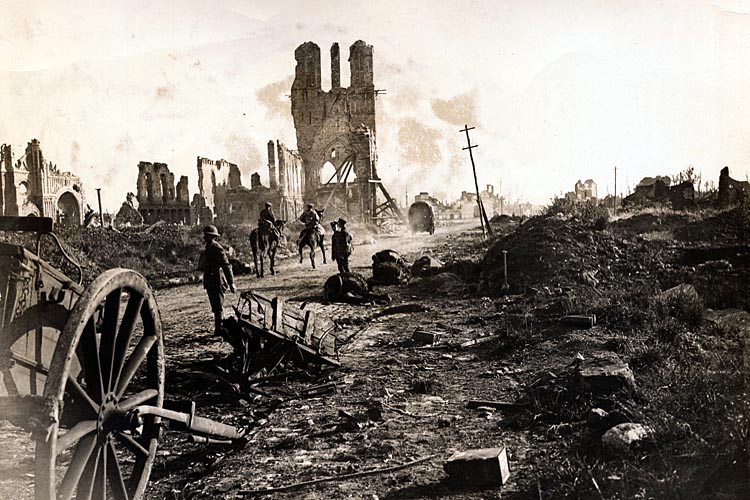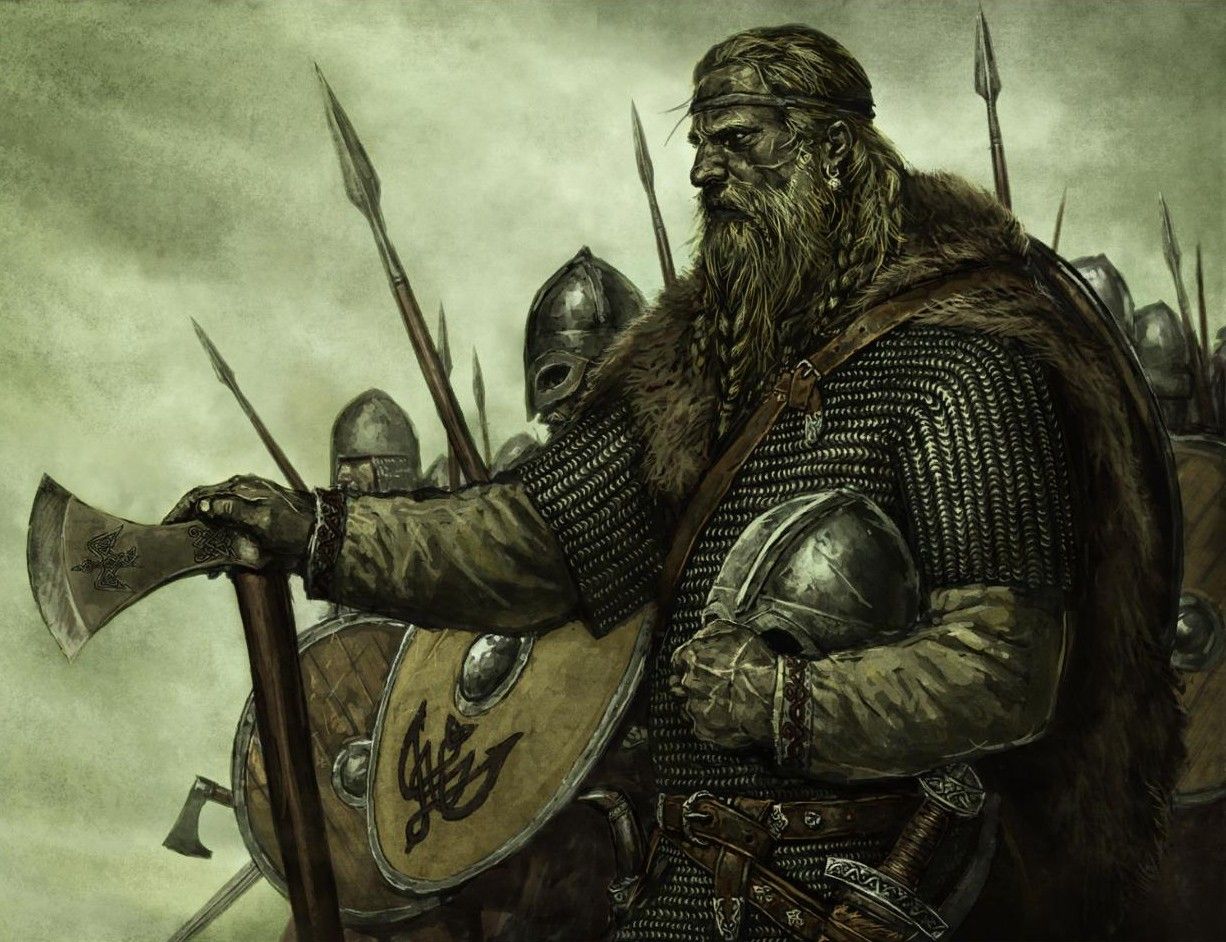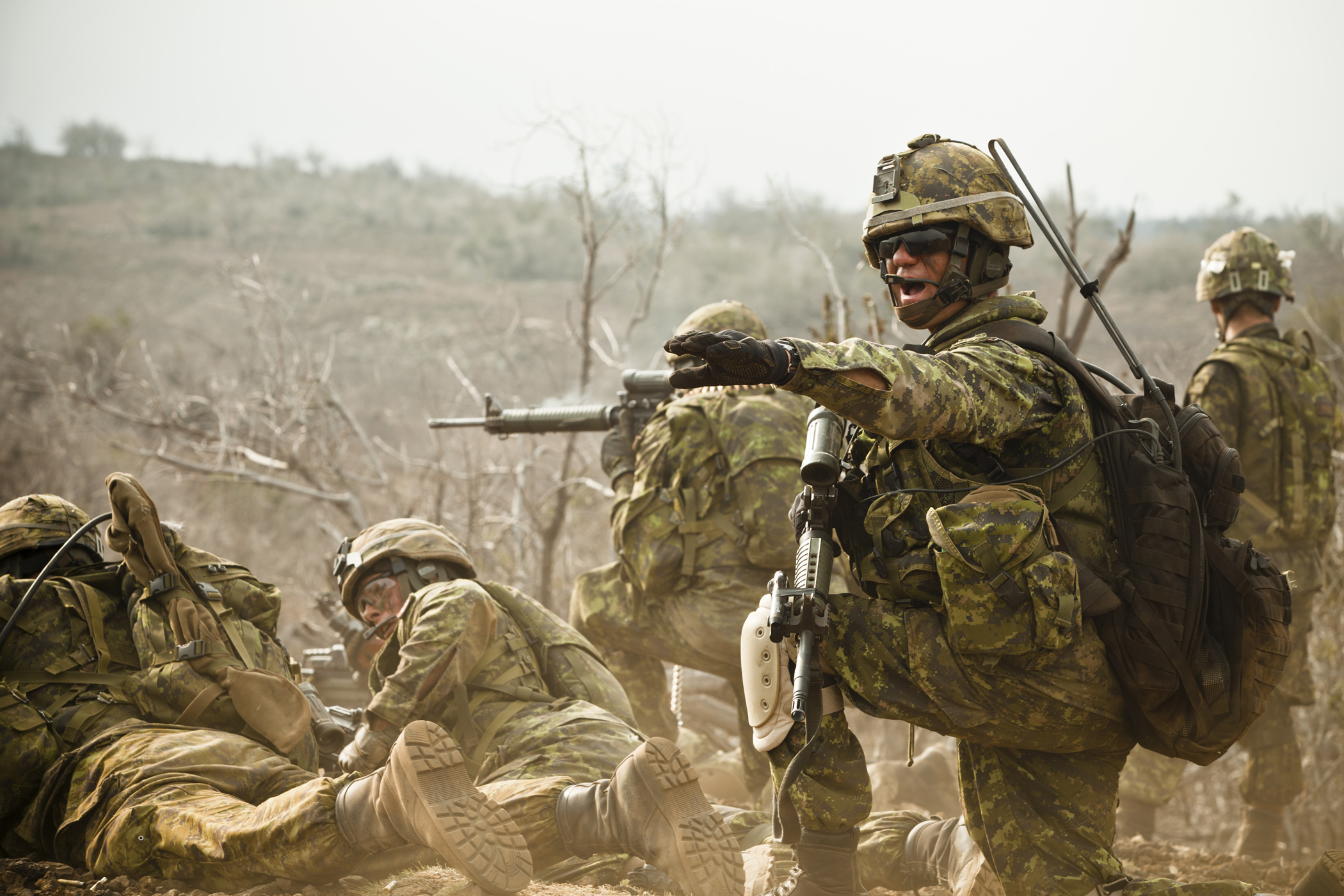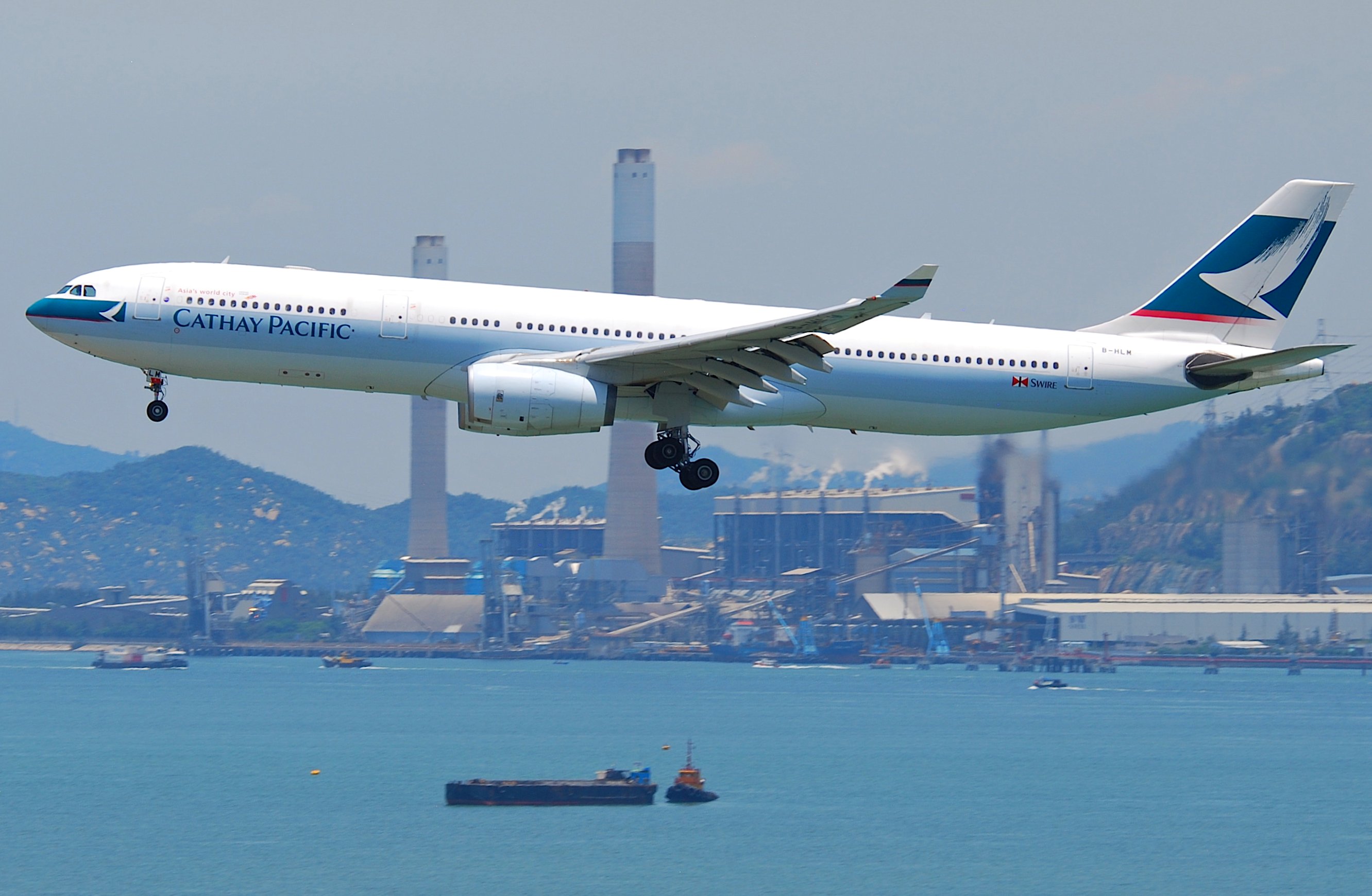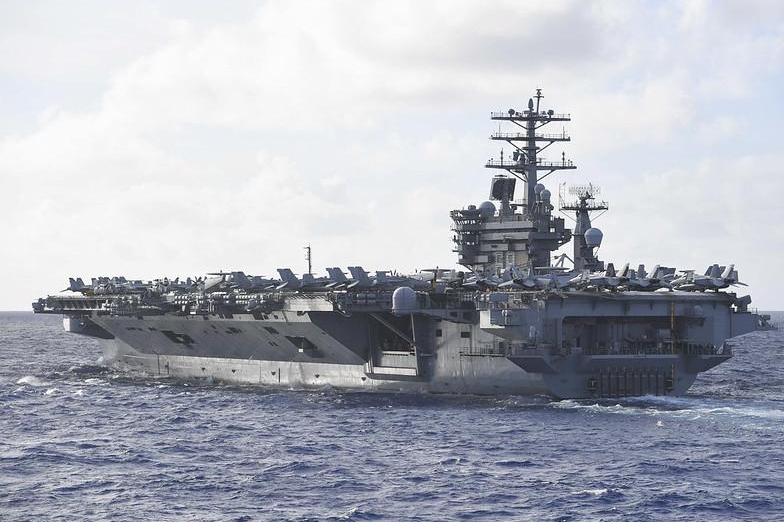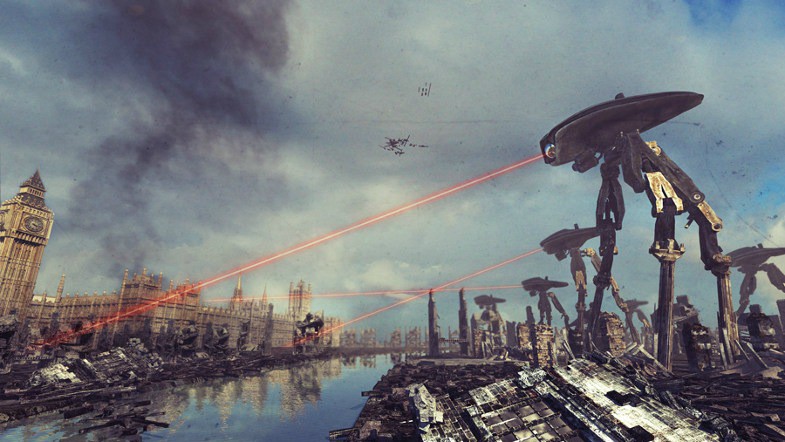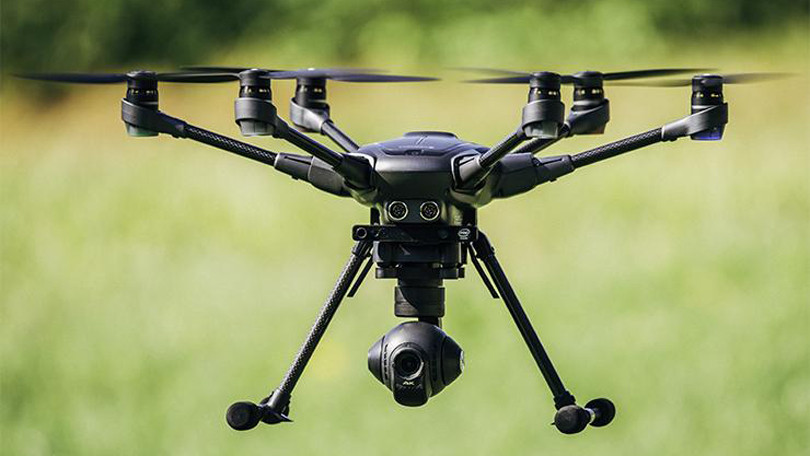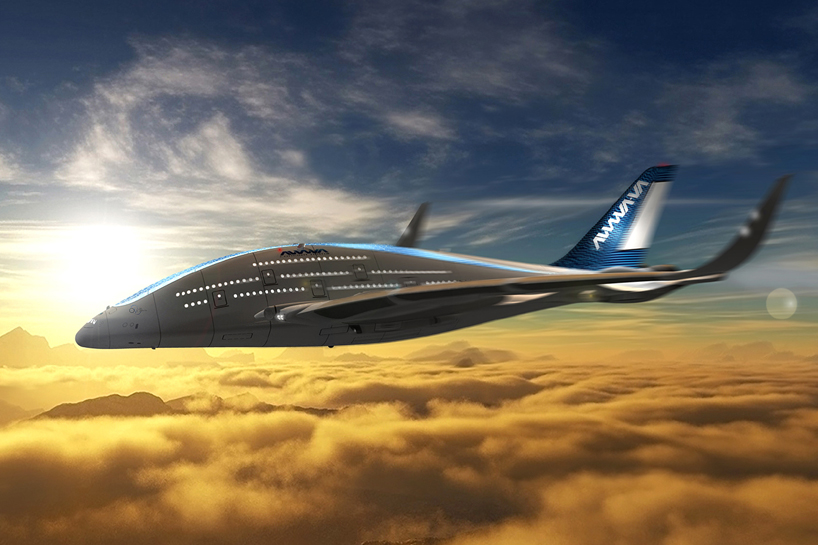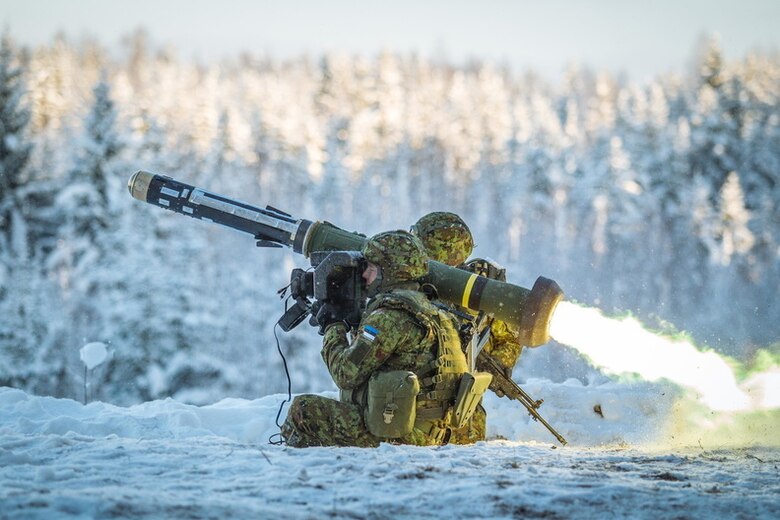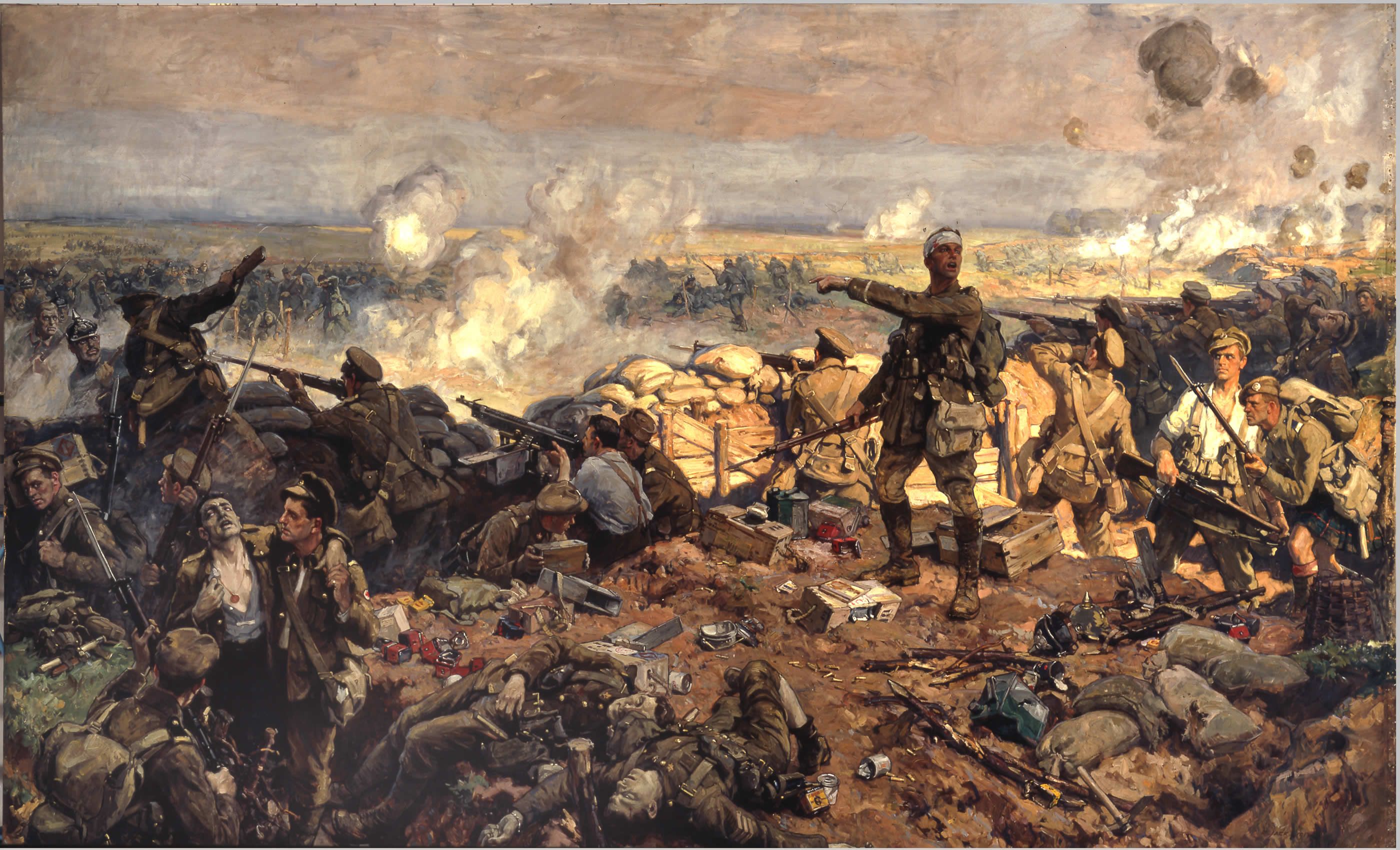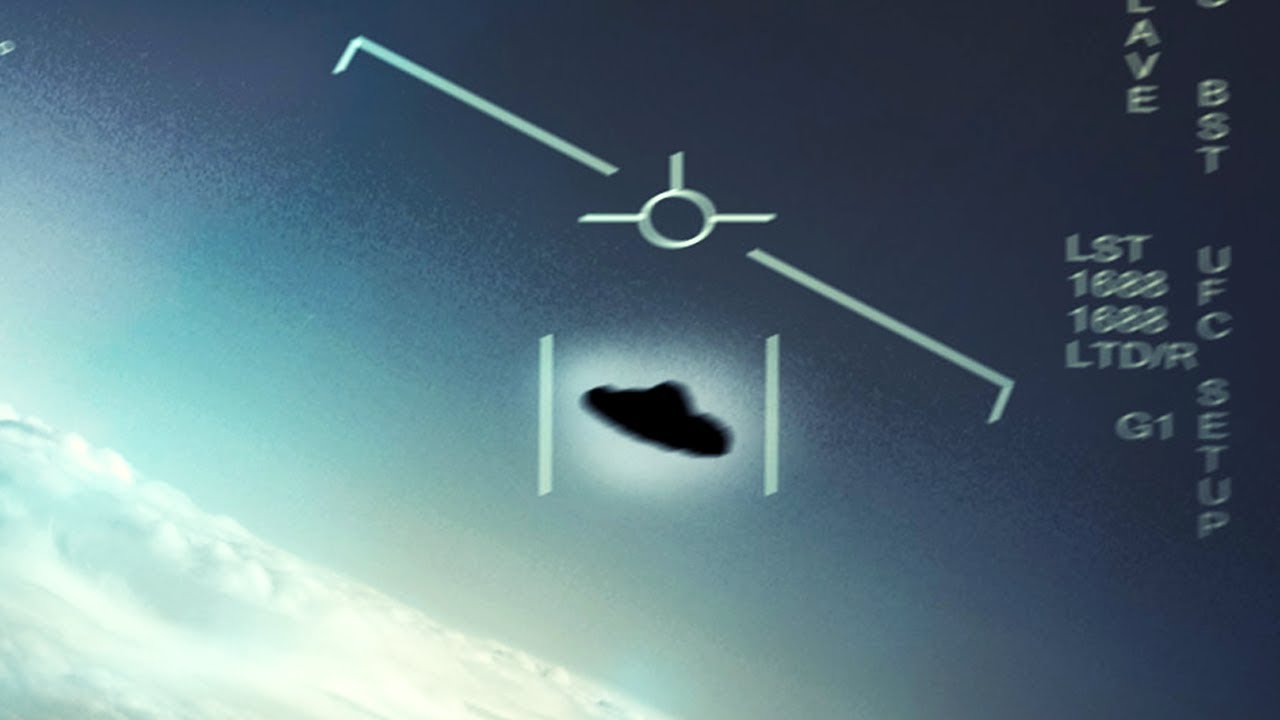No runway, no problem—have helicopter, will travel! Igor Sikorsky (1889–1972), father of the modern chopper, had no doubt at all about the brilliance of this amazing, flying machine, which he said was the closest thing to "fulfillment of mankind's ancient dreams of the flying horse and the magic carpet." Jet planes are wonderful for screaming us from one side of the planet to the other. But when it comes to tricky rescue missions—plucking stranded sailors from the sea, hurling tubs of water onto forest fires, plucking engineers off wind turbines, dashing the critically injured to hospital—nothing beats a chopper. According to science historians, inventors had been trying to develop flying machines with spinning rotors for over 2000 years before Sikorsky finally built the world's first practical helicopter in 1939. Why did it take so long? Because helicopters are incredibly complex machines—miracles of intricate engineering that take real skill to fly. How exactly do they work? Let's take a closer look!
Photo: The US Navy's largest helicopter: the CH53-E Sikorsky Super Stallion. A newer version, the CH-53K, is currently under development and expected to cost about $100 million per helicopter! Picture by Joshua Adam Nuzzo courtesy of US Navy.
How does a helicopter stay in the air?
The science of a helicopter is exactly the same as the science of an airplane: it works by generating lift—an upward-pushing force that overcomes its weight and sweeps it into the air. Planes make lift with airfoils (wings that have a curved cross-section). As they shoot forwards, their wings change the pressure and direction of the oncoming air, forcing it down behind them and powering them up into the sky: a plane's engines speed it forward, while its wings fling it up. The big problem with a plane is that lots of air has to race across its wings to generate enough lift; that means it needs large wings, it has to fly fast, and it needs a long runway for takeoff and landing.

Photo: Mighty rotors: You can see just how big and heavy a helicopter's rotors are in this picture. It takes four US marines to hold this rotor in place while it's being reattached after maintenance. Notice the curved front edge of the rotor blade that cuts like an airfoil as it spins around. Picture by Jeremy L. Grisham courtesy of US Navy.
Helicopters also make air move over airfoils to generate lift, but instead of having their airfoils in a single fixed wing, they have them built into their rotor blades, which spin around at high speed (roughly 500 RPM, revolutions per minute). The rotors are like thin wings, "running" on the spot, generating a massive downdraft of air that blows the helicopter upward. With skillful piloting, a helicopter can take off or land vertically, hover or spin on the spot, or drift gently in any direction—and you can't do any of that in a conventional plane.
Key parts of a helicopter
A typical helicopter has thousands of intricate components, but we only need to worry about a handful of the bigger bits. The main framework is called the fuselage and it's typically made from strong but relatively lightweight composite materials. It contains one or two engines, a transmission, and gearboxes, which power one or two main rotors and a much smaller tail rotor at the back.
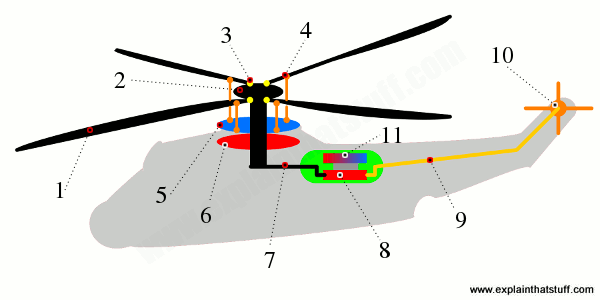
Artwork: A quick summary of the essential, mechanical parts of a helicopter. Each rotor blade (1) is connected to the hub (2) and rotating mast by a feathering hinge (3), which allows it to swivel. A pitch link (a short rod) attached to each blade (4, orange) can tilt it to a steeper or shallower angle according to the position of the rotating upper swash plate (5, blue), which spins on bearings around the static lower swash plate (6, red). That's how a chopper hovers and steers and it's described in more detail later in this article. The two swash plates are moved up and down or tilted to the side by the pilot's cyclic and collective cockpit controls (not shown), which are explained below. The rotor is powered by a driveshaft (7) connected to a transmission and gearbox (8, red). The same transmission powers a second, longer driveshaft (9, yellow) connected to a gearbox that spins the tail rotor (10, orange). The power from both rotors comes from one or two turboshaft jet engines (11).
Engines
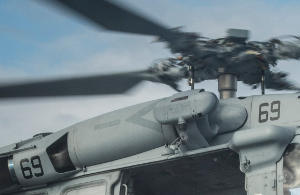
Photo: Helicopter engine: Look under the rotor of this Seahawk helicopter. The long, gray tube between the two sets of numbers ("69") is a turboshaft jet engine. There's a second engine exactly the same on the other side. Photo by Trevor Kohlrus courtesy of US Navy.
Although some small helicopters still use piston engines (also called reciprocating engines, similar to the ones used in cars and trucks), most now use gas turbines more like the jet engines on conventional airplanes. Turbine engines are smoother in operation (vibrating much less), more powerful, less mechanically complex, and more reliable. Some helicopters have a single engine mounted horizontally, underneath and just behind the rotor; most small Bell helicopters, for example, work like this. Others have one engine mounted either side of the rotor mast; military Seahawk and Apache helicopters are powered this way. Most modern choppers have turboshaft engines, which are similar to normal jet engines on airplanes. However, instead of squirting out a hot jet of exhaust gas that thrusts them forward, they use the energy from the burning gas to spin a central turbine and driveshaft that powers the transmission (the mechanism that allows the engine to power the rotors). Our main article on jet engines tells you more about how turbojet engines work.
Main rotor
The huge spinning rotor is the single most noticeable feature of any helicopter, but no chopper can get by with just one rotor. Why? A basic principle of physics called Newton's third law of motion tells us that when a force (called an action) makes something move, another force, just as big (called a reaction), makes something else move in the opposite direction; action and reaction are equal and opposite is another way of putting it. As a helicopter rotor spins around (the action), the entire body of the craft tends to rotate somewhat more slowly in the opposite direction (the reaction). Left to its own devices, this torque (turning force) would make a helicopter completely uncontrollable, so we have to counteract it in some way with what's called counter-torque (a turning force in the opposite direction). One solution is to have a second large rotor spinning the other way. Sometimes this is mounted on the same mast as the first rotor (a design called a coaxial rotor); sometimes, as in the huge military Chinook helicopters, there's a large rotor at either end of the craft (a design called a tandem rotor).
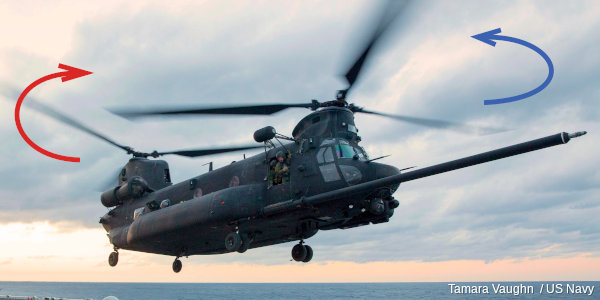
Photo: Tandem rotor: This military Boeing CH-47 Chinook has one rotor at the front and one at the back and they spin in opposite directions to cancel one another's torque. Photo by Tamara Vaughn courtesy of US Navy.
The blades of a helicopter's main rotor come in three basic kinds that allow increasing amounts of movement as they spin around: they're called rigid, semi-rigid, and fully articulated. As the name suggests, rigid blades are firmly attached to the rotor hub (the "wheel" to which the blades are fixed at the top of the spinning rotor mast) by a swiveling connection called a feathering hinge (or pitch hinge). This allows them to "feather" (swivel as they rotate, which, as we'll discover in a moment, is how a helicopter steers). Semi-rigid blades have the same feathering hinge, but they also have a teetering hinge (or flapping hinge) that lets them flap up and down. Fully articulated blades can feather and flap, and they also have a third hinge (a drag hinge) that allows them to move slightly ahead of ("lead") or behind ("lag") their normal position. Each of these blade types has advantages and drawbacks.
Tail rotor
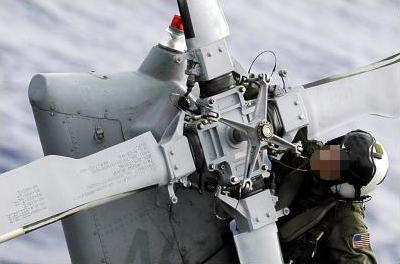
Photo: The tail rotor of a Seahawk helicopter. The tail rotor is driven by a drive shaft running back from the main engines, parallel to the body of the helicopter. If you look closely, you'll see that the blades of the rotor can be tilted by the pilot as they spin around, which generates more or less pushing force and gives the helicopter the ability to rotate on the spot as it hovers. Picture by James R. Evans courtesy of US Navy.
Apart from adding a second large rotor, another way to counteract the torque from the main rotor is by using a small, sideways-pointing propeller called a tail rotor, powered by a driveshaft from the engine that runs through the tail end of the craft. Sometimes, for safety reasons, the tail rotor is built right inside the tail (a design called a fenestron or fan-tail). Another alternative is called a NOTAR® ("no tail rotor"), which uses a jet of air, fired through a vent on the tail, to counteract the main rotor torque instead. If a helicopter has a single main rotor blade, it has to have a tail rotor, fenestron, or NOTAR or it can't fly safely; similarly, any damage to the tail rotor—such as a bird strike or missile hit—makes a copter dangerously uncontrollable and usually results in it crashing quite quickly afterward. Most helicopters have a vertical tail fin (pylon) that also helps to counteract some of the torque from the main rotor.
How does a helicopter hover and steer?
A helicopter's rotors are ingenious things that allow it to hover in mid-air or steer in any direction. The pilot has five basic movement and steering controls: two hand levers called the collective and cyclic pitch, a throttle, and two foot pedals. Most maneuvers that a pilot executes involve a complex interplay between these different controls, which is why flying a helicopter requires such skill and concentration.
Hovering
As they start to spin around, the airfoils on the rotor blades generate lift that overcomes the weight of the craft, pushing it up into the air. If the lift is greater than the weight, the helicopter climbs; if it's less than the weight, the helicopter falls. When the lift and the weight are exactly equal, the helicopter hovers in mid-air. The pilot can make the rotor blades generate more or less lift using a control called the collective pitch (or "collective"), which increases or decreases the angle ("pitch") that all the blades make to the oncoming air as they spin around. For takeoff, the blades need to make a steep angle to generate maximum lift.

Artwork: How a helicopter hovers and steers: Top drawing: The collective pitch control changes the angle (or pitch) of each of the rotor blades by the same amount at the same time (green arrows)—in other words, collectively. If the blades make a steeper angle, they generate more lift so the entire craft moves straight upward (orange arrow). Bottom drawing: The cyclic pitch control changes the angle of selective rotor blades as they spin, so (in this case) whichever blade is on the left always produces slightly more lift, while the opposite blade (shown here on the right) always produces slightly less lift. That means more lift is produced on the left side of the helicopter, so the overall lift (orange arrow) is tilted to the right, steering the entire helicopter in that direction.
How does that happen? As we've already seen, the main rotor is connected to the hub at the top of the mast by a feathering hinge that allows each blade to swivel as it spins, so it makes a steeper or shallower angle to the oncoming air. The blades have short vertical rods (pitch links) attached to them that are connected to a rotating metal disc called a swash plate, a bit lower down the mast. This swash plate slides on bearings around a second, similar plate directly underneath that doesn't rotate. When the pilot moves the collective one way, both swash plates move upward, pushing up on the pitch links that tilt the rotor blades to a steeper angle. Moving the collective the other way moves the swash plates back down, pulling on the pitch links and tilting the blades to a shallower angle.
At the end of the collective, there's a throttle connected by a cable to the engine. This is like the accelerator of a car or the throttle of a motorbike, increasing or decreasing the engine speed so the rotor makes more or less lift.
Steering
The rotors also provide the steering for a helicopter by making more lift on one side than the other. They do this by swiveling back and forth (feathering) as they rotate, so, for example, they make a steeper angle when they're on the left side of the craft than when they're on the right. That means they generate more lift on the left, tilting the craft over to the right and steering it in that direction. The pilot steers like this using a second lever called the cyclic pitch (also known as the "cyclic stick" or just "cyclic"), similar to a joystick, which makes the blades swivel as they cycle around. The ingenious swash plate mechanism translates the pilot's movements into appropriate movements of the rotor blades. Suppose the pilot wants to fly to the right. First, she moves the cyclic to the right, and a system of connected levers makes the two swash plates tilt to the right as well. This makes the rotor blades tilt to a steep angle when they're on the left and a shallow angle when they're on the right, so the rotor produces more lift on the left hand side, steering the craft to the right.
<p">
Artwork: How the swash plate steers a helicopter. In the center, you can see a simplified view of the swash plate mechanism. There are two discs at the top of the rotor mast, an upper one (red) that rotates on ball bearings (orange) around a lower one (blue) that doesn't rotate at all. Four pitch links (green) connect the upper swash plate to the rotor blades. Now suppose you want to fly to the right. You tilt the cyclic in that direction. That tilts both swash plates over to the right. As the rotor blades rotate, the tilted swash plates force the pitch links up when they're on the left and down when they're on the right. That makes each rotor blade tilt to a steeper angle when it's on the left and a shallower angle when it's on the right. This produces more lift on the left, steering the chopper to the right.
The pilot can also steer the nose of a helicopter in a certain direction using a pair of foot controls, known as antitorque pedals, which change the pitch of the tail rotor blades so they make more or less sideways thrust than in normal straight flight. That makes the entire craft rotate slowly clockwise or counterclockwise so it heads in a different direction. On tandem rotor helicopters like the Chinook, which have no tail rotor, the foot pedals tilt the swashplates for the front and back rotors in opposite ways, steering the craft accordingly.
How helicopter rotors work
Everyone knows a helicopter's rotors rotate (that's why they're called rotors). But the really clever thing about them is that the blades can swivel back and forth as they turn around—and that requires some amazingly intricate machinery.
It's easy to mimic a helicopter with your arms and your body's hidden structure makes the movements seem easy. Stand up with your arms outstretched horizontally. Rotate your whole body slowly on the spot. As you're turning around, swivel your arms at the shoulders. That's roughly what a helicopter does with its blades, except that it does it about 3–4 times each second as the blades are spinning round!

Photo: A US Navy engineer checks the rotor assembly on a Seahawk helicopter. Picture by Kathaleen A. Knowles courtesy of US Navy with annotations by Explain that Stuff.
Here are the main bits that make it work:
- The blades are shaped like airfoils (airplane wings with a curved profile) so they generate lift as they spin.
- Each blade can swivel about a feathering hinge as it spins.
- Vertical pitch links push the blades up and down, making them swivel as they rotate. The pitch links move up and down according to the angle of the swash plates.
- The rotor mast (a central axle connected to the engine by the transmission) makes the entire blade assembly rotate.
- The rotor hub cap (above the rotors) helps to reduce aerodynamic drag.
- There are two turbo-shaft jet engines, one on either side of the rotors. If one engine fails, there should still be enough power from the other engine to land the helicopter safely.
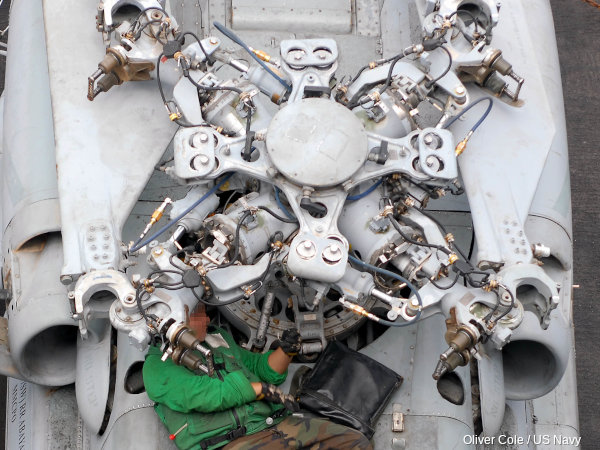
Photo: An engineer repairs the amazingly intricate and complex rotor mechanism of a Seahawk, viewed here from directly above. The engines are the two open cones on either side. You can also see two of the rotor blades folded back along the fuselage (and pointing upward in this picture), which means the Seahawk can be parked on aircraft carriers in much less space. Photo by Oliver Cole courtesy of US Navy.
How Sikorsky designed the modern helicopter rotor
All this sounds ingenious—and it is! The person who made it possible was brilliant Russian-born inventor Igor Sikorsky. Here are two of his original helicopter design drawings, taken from the patent for a Direct Lift Aircraft (helicopter) he filed in June 1931:

Artwork: Igor Sikorsky's original patent drawings, with colors and annotations added for clarity. From US Patent #1,994,488: Direct Lift Aircraft, courtesy of US Patent and Trademark Office.
Notice how similar the mechanism is to what we find on a modern helicopter? The patent is extremely detailed and quite complex (you can check it out for yourself), so I've removed most of the labels and numbers and highlighted just a few key features:
- There's an aileron at the end of each rotor blade, shown in orange.
- The ailerons can be tilted (as they rotate) by the blue rods.
- There are two main rotor blades (which Sikorsky referred to collectively as the "lift propeller."
- The entire rotor blades can swivel on the green rods and can also be tilted as they rotate.
- The main rotor blade rotates around a central hub (yellow) with an engine beneath it.
- A single engine powers both the main rotor blade and the tail rotor. One of Sikorsky's key innovations was to produce a helicopter that needed only one main rotor blade, with a tail rotor to balance it, for reasons discussed below. As Sikorsky noted in his patent, having only one rotor means a helicopter is "light in weight, simple to construct, and cheap to produce"—three powerful advantages over earlier designs!
Advantages and disadvantages of helicopters

Photo: Alternatives to a helicopter#1: Vertical/Short Takeoff and Landing (V/STOL) aircraft, like the famous Harrier, shown here, try to combine the maneuverability of a helicopter with the speed of a plane. A Harrier can hover because, unlike a traditional jet engine, it has four extra nozzles on the side that can swivel around to direct the engine's exhaust gases straight downward. Picture by Staci Bitzer courtesy of US Navy.
Choppers have lots of advantages over planes. You don't need a runway, for starters, or big wings, and you can operate helicopters more easily from ships. From the center of a city to the middle of a jungle, you can take off or land more or less anywhere. You can pause, mid-flight, to rescue someone, pick up a load, or drop it off with a winch. Admittedly, you can't usually fly as fast or as far as a plane, or carry as many people or as much cargo, but you have much more flexibility in where you can go.
Unfortunately, this versatility comes at a price: helicopters with spinning rotors are mechanically more complex than planes with static wings, more prone to failure, need more maintenance, and are expensive to operate. Since you can fly a helicopter in all kinds of ways—it's effectively several different flying craft all rolled into one—you might think piloting a chopper is automatically harder than flying a plane. But there's no real comparison, because they're two totally different things.

Photos: Alternatives to a helicopter#2: Bell Boeing's V-22 Osprey has huge rotors at the front that can be tilted to point upward (like a helicopter) or forward (like a plane), combining the advantages of both in a single aircraft. Photos (left to right) by Andy M. Kin,Oscar Espinoza, and Zachary L. Borden, all courtesy of US Navy.
A brief history of helicopters
“A flying machine offering reasonable speed and which would be controllable and safe, also combining take‐off and landing ability in a small area, would be of great value and would be, unquestionably, in considerable demand.”
Igor Sikorksy, 1930
- 400BCE: A Chinese book reveals how to make a "flying top" helicopter toy using spinning feathers attached to the end of a stick. You spin the stick quickly between your hands, hurl it into the air, and the feathers make it fly.
- 1483: Italian inventor Leonardo da Vinci (1452–1519) designs a helicopter with corkscrew-shaped propeller blades to pull it up through the air. He doesn't build it, however.
- 1754: Russian engineer Mikhail Lomonosov (1711–1765) builds a small working model showing how a gear mechanism can drive a pair of coaxial, counter-rotating helicopter blades.
- 1796: British aircraft pioneer Sir George Cayley (1773–1857) builds spring- and elastic-powered models of helicopters that fly to impressive heights (tens of meters). Later, in 1843, he sketches plans for a full-scale helicopter with two rotors, but the steam enginesavailable at that time are much too heavy to power it.
- 1880s: American inventor genius Thomas Edison (1847–1931) experiments with model helicopters, including some driven by electricity, his favorite source of power.
- 1901: Igor Sikorsky (1889–1972), a Russian aircraft engineer, builds himself a working model helicopter powered by a rubber band. It's the beginning of a life's obsession with helicopters—one that will change the world.
- 1904: Frenchman Charles Richet (1850–1935) builds a small helicopter, but it doesn't carry a pilot.
- 1907. Frenchman Louis Breguet (1880–1955), a student of Charles Richet, and his brother build a quadrotor helicopter (the Breguet-Richet gyroplane) with a rotor at each corner. It can fly about a meter off the ground for a minute or so at a time. Later the same year, another Frenchman, Paul Cornu (1881-1944), builds a small helicopter that can lift off for about 20 seconds.
- 1916: Austrian aerodynamic genius Theodore von Kármán (1881–1963) helps to design a helicopter called the Petróczy, Kármán and Žurovec-1 (PKZ-1), driven by an electric motor, that proves powerful enough to lift three men.
- 1920: Spaniard Juan de la Cierva (1895–1936) invents the autogyro, a small, flying airplane with a rotor on top.
- 1931: After many years of experimenting, Igor Sikorsky designs and patents a practical, working helicopter. He finally builds and flies a version of it, the VS-300, in 1939.
- 1942: Sikorsky's R-4 becomes the world's first mass-produced helicopter.
- 1945: Frank Piasecki (1919–2008) pioneers the revolutionary tandem-rotor helicopter. His original version is nicknamed the Flying Banana and eventually evolves into the Chinook.
- 1946: Bell Aircraft introduces the Model 47, designed by Arthur Young (1905–1995), the world's first commercially successful helicopter.
- 1950–1953: Helicopters demonstrate their true military potential for the first time during the Korean War.
- 1951: Charles Kaman builds the K-225, the first gas-turbine engined helicopter. Three years later, he builds the first twin-turbine helicopter, the HTK-1, for the US Navy.
- 1961: Boeing's fast, cargo-carrying tandem rotor CH-47 Chinook helicopter makes its maiden flight (entering production the following year). It can manage loads of up to 10 tonnes.
- 1964: Frenchman Paul Fabre of Sud Aviation develops the fenestron.
- 1967: Two Sikorsky S-61R helicopters make the first ever non-stop, transatlantic flight from New York City to Paris, France in a time of 30 hours 46 minutes.
- 1981: NOTAR® (no tail rotor) is tested for the first time on a Hughes OH-6A helicopter.
- 1988: Bell-Boeing begins production of its V-22 Osprey, a tilt-rotor aircraft that can take off like a helicopter but fly like a plane.
- 1989: The McDonald Douglas 520N, the first mass-produced NOTAR® helicopter, makes its maiden flight on December 28, 1989.


